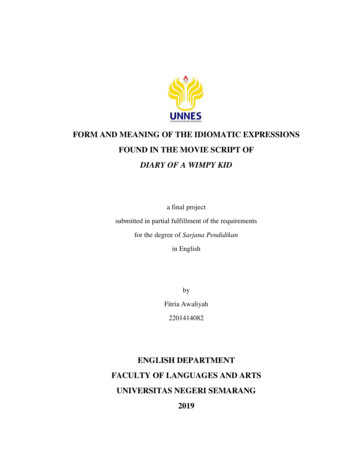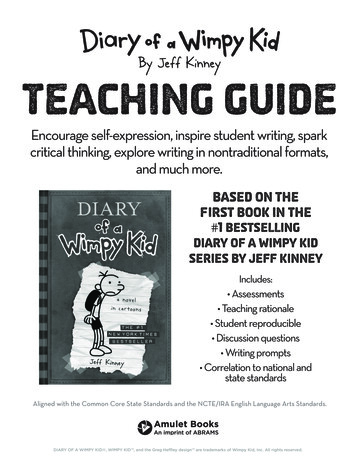
Transcription
FORM AND MEANING OF THE IDIOMATIC EXPRESSIONSFOUND IN THE MOVIE SCRIPT OFDIARY OF A WIMPY KIDa final projectsubmitted in partial fulfillment of the requirementsfor the degree of Sarjana Pendidikanin EnglishbyFitria Awaliyah2201414082ENGLISH DEPARTMENTFACULTY OF LANGUAGES AND ARTSUNIVERSITAS NEGERI SEMARANG2019i
ii
DECLARATION OF ORIGINALITYI, Fitria Awaliyah, hereby declare that this final project entitled Form and Meaning ofthe Idiomatic Expressions Found in the Movie Script of Diary of a Wimpy Kid is myown work and has not been submitted in any form for another degree or diploma at anyuniversity or other institutes of tertiary education. Information derived from publishedand unpublished work of others has been acknowledged in the text and a list ofreferences is given in the references.Semarang, August 9th 2019Fitria AwaliyahNIM 2201414082iii
MOTTOSFor indeed, with hardship [will be] ease.Indeed with hardship [will be] ease.So when you have finished [your duties] then stand up [for worship].And to your Lord direct [your] longing.(Q.S. Al-Insyirah: 5-8)Allah does not burden a soul beyond that it can bear.(Q.S. Al-Baqarah: 286)To my own self, my support systems (mother and father), Universitas NegeriSemarang, and those who still struggle to graduate, never give up!iv
ACKNOWLEDGEMENTSIn the name of Allah, the Most Gracious and the Most Merciful. Alhamdulillah, Allpraises to Allah God Almighty for every blessing, chance, and ease given to me infinishing this final project.My deepest gratitude and appreciation are to my advisor, Intan PermataHapsari, S. Pd., M. Pd. for her patience, guidance and time during my consultations forthis final project. My deepest gratitude are also addressed to Prof. Dr. MuhammadJazuli, M.Hum. and Dr. Rudi Hartono, S.S., M.Pd. as the chairman and the secretaryof the examination, as well as the board of examiners, Dra. Sri Suprapti, M.Pd. as thefirst examiner and Alief Noor Farida, S.Pd., M.Pd. as the second examiner who hasexamined my final project, given criticisms, comments, and supporting advice for theimprovement of this study. I would like to express my gratitude to the Dean ofLanguage and Arts Faculty and all lecturers of the English Department of UNNES whohave given beneficial and priceless knowledge to me during my study in UNNES.Special thanks to my beloved family (Mama Kariyah and Bapak Karsono) fortheir endless affections, supports, and prayers. Also biggest thanks for my secondfamily at Ungu boarding house, Indra Kila boarding house, LINGUABASE, OBSESI,PPL, KKN, and all my friends in English Department of UNNES, for all preciousmoments we spent together during my study in college.Finally, I would like to express my thankfulness for all the readers of this finalproject. I am looking forward to the suggestions and criticisms for the better of thisfinal project.Semarang, August 9th 2019Fitria Awaliyahv
ABSTRACTAwaliyah, Fitria. 2019. Form and Meaning of the Idiomatic Expressions Found inthe Movie Script of Diary of a Wimpy Kid. Final Project. English Education. Facultyof Languages and Arts. Universitas Negeri Semarang. Advisor: Intan Permata Hapsari,S.Pd., M.Pd.Keywords: Idiomatic expression, meaning, formLearning idioms is important but their meanings are elusive and cannot betranslated literally. It makes sense that most of foreign students, especially Indonesianstudents, surely deal with difficulties in learning English idioms. A movie can be aresource of idioms since it has abundance of idiom utterances. Learning trough moviealso helps students to understand idioms in a right context. Diary of a Wimpy Kid is amovie intended for teenagers contains everyday language conversations. Based onthose reasons, this topic was chosen.This study aimed at finding (1) form categories of idiomatic expressions inthe Diary of a Wimpy Kid movie script; and, (2) the meaning types of each idiomaticexpression in Diary of a Wimpy Kid movie script. According to the aim of this study,this study employed a descriptive-qualitative method. This study tried to figure out theresearch questions by conducting some procedures such as collecting the data,categorizing the data, and concluding the findings.The objects of the study were all the idiomatic expressions found in Diary ofa Wimpy Kid movie script adapted from a novel with the same title Diary of a WimpyKid by Jeff Kinney. The data were the phrases or words found in the movie script. Thedata obtained were categorized into meaning types and form categories. The formcategory was according to the formation of the idiom that referred to Adelnia &Dastjerdi’s theory (2011). The meaning type was based on the meaning of the idiomthat used Fernando’s theory (1996).The total of the idioms found in the movie script was 132 idioms. In formcategories, there were 22 colloquialisms (17%), 9 proverbs (7%), 22 slangs (17%), 2allusions (1%), and 77 phrasal verbs (58%). In meaning types, there were 83 pureidioms (63%) and 49 semi idioms (37%).Based on the five form categories, the most frequently used idiom was phrasalverb, followed by colloquialism, slang, proverb, and allusion. Meanwhile, in meaningidiom types, the most dominant idiom was pure idiom followed by semi idiom.vi
TABLE OF CONTENTSAPPROVAL. Error! Bookmark not defined.DECLARATION OF ORIGINALITY . iiiMOTTO . ivACKNOWLEDGEMENT .vABSTRACT . viTABLE OF CONTENTS . viiCHAPTER I .1INTRODUCTION .11.1 Background of the Study .11.2 Reasons for Choosing the Topic .51.3 Research Problems.61.4 Purposes of the Study .61.5 Significance of the Study .61.6 Outline of the Study .7CHAPTER II .8REVIEW OF RELATED LITERATURE .82.1 Review of Previous Studies .82.2 Review of Theoretical Studies .112.2.1Definition of Idiom . 122.2.2Characteristic of Idiom . 152.2.3Kinds of Idiom . 182.2.4The Interpretation of Idiom . 262.2.5Definition of Movie. 282.2.6Elements of Movie . 292.2.7Genres of Movie. 392.2.8Definition of Movie Script . 422.3 Theoretical Framework .43CHAPTER III .44METHODS OF INVESTIGATION .443.1 Research Design .443.2 Object of the Study .453.2.1Author’s Biography. 45vii
3.2.2The Director’s Biography . 473.2.3The Plot of Diary of a Wimpy Kid . 483.3 Role of Researcher .503.4 Methods of Collecting Data .503.5 Methods of Categorizing Data .52CHAPTER IV .54THE IDIOMATIC EXPRESSIONS .54FOUND IN DIARY OF A WIMPY KID MOVIE SCRIPT .544.1 The Result of Idiomatic Expressions Found in Diary of a Wimpy Kid MovieScript .554.2 Discussion .82CHAPTER V.85CONCLUSIONS AND SUGGESTIONS .855.1 Conclusions .855.2 Suggestions .86REFERENCES.87APPENDIX .91viii
CHAPTER IINTRODUCTIONThis chapter presents the background of the study, reasons for choosingthe topic, research problems, purposes of the study, significance of the study, andoutline of the study.1.1 Background of the StudyHuman is a social creature who is not able to live alone and alwayscommunicates each other. The most important property of human’scommunication is language. Human’s language can be represented by signssuch as words and body movements. By using language, they can express whatis in his mind and heart which he probably wants to share to others clearly. Itis hard to imagine how people can cooperate and get along with one anotherwithout language.There are plentiful different languages in the world such as Malay,Dutch, French, Indonesian, Russian, Japanese, Chinese, English, etc. Thedifferences of languages can be caused by geographic, demographic, andcultural factors. Therefore, each language by all means has specialcharacteristics in its vocabulary items, sound system, rules of composing wordsinto sentences, and even ways of writing.As the time progresses, people need to conduct cooperation withother countries. This cooperation with other countries is needed for the sake ofwidening their capability in many fields such as ideology, politics, economics,science, social, culture, defense, and security. For instance, in the field of1
2ideology, a country takes advantage of this cooperation by honouring othercountries even though their ideologies are different. The advantage in the fieldof politics is that a country has the same orientation in national interests. Theyalso can conduct mutual cooperation in the field of economics to increasepublic welfare by doing export and import trade. Each country is also able toexchange information, education and even technology by allowing foreignlearners to study in their country and vice versa. In the field of social andculture, each country can complete each other but still maintain their own socialand cultural personality. The advantage in the field of defense and security, acountry can conduct a war game with another country to improve theircapability of defense and security. Those examples above are some strongreasons of why we have to learn foreign language.Learning foreign language will obviously be difficult for mostIndonesian students. One of foreign languages which students have to study isEnglish. Even though English is taught formally in school from Junior HighSchool up to Senior High School level, students nowadays still face lots ofproblematical matter. Ramelan (2003, p. 5) stated that the difficultyencountered by a student in learning a second language is caused by thedifferent elements found between his language and the target language. Thedegree of difficulty in learning is also determined by the degree of differencebetween the two languages. The greater the similarity between them, the lessdifficult it will be for the student to learn the foreign language.
3Talking about English language learning, we are not going to be farfrom learning English words as the basic units of language. The richervocabulary a student masters the better he learns English. According toCarstairs and McCarthy (2002, p. 5) words tend to be two differentcharacteristics:We may be tempted think that this constitutes everything that needsto be said about words: they are units of language which are basic in two senses,both(1) in that they have meanings that are unpredictable and so must be listed indictionaries, and(2) in that they are the building-blocks out of which phrases and sentences areformed.In this study, let us be more focus on lexical items which haveunpredictable meanings and are listed in dictionaries as idioms. Most of theworld’s languages have phrases or sentences that cannot be understoodliterally. Even if you know all the words in a phrase and understand all thegrammar of the phrase completely, the meaning may still be elusive. A phraseor sentence of this type is said to be idiomatic (Spears, 1998, p. v). Idioms aregroups of phrases which are used together with persistent arrangements andmeanings. There are abundance of idioms in English. As they do not standalone and have unpredictable meanings, we cannot look their meanings up in adictionary word by word. In other words, their grammatical constructioncannot be changed separately. For example, the idiom “look after” which has
4meaning to take care of cannot be separated by “look” which means as seem tobe and “after” which means as later in time.In line with the explanations above, for idioms have unpredictablemeanings, it makes sense that most of foreign students, especially Indonesianstudents, surely deal with many problems in learning English idioms. Hence, itis truly important for Indonesian students to master English idioms well inorder to improve their English skills.English has four basic skills i.e. listening, speaking, reading, andwriting that students have to master for completing their learning. There aremany sources for learning idioms. As said by Thyab (2016, p. 109), newspapersand magazines, radio programs, television shows and films are also sources ofidioms. Watching movie is a great option for students to learn idioms becausemovie contains a lot of idiomatical expressions. You will be surprised to knowthat phrases and idioms spoken many, many years back have now beenengraved in the human psyche, and many idioms and phrases, or theirmutations, are commonly used in advertisements and in film dialogues (Corelli,2005) as cited in De Caro (2009, p. 129). When we watch a movie, we trulylearn the language exactly found in real life. The language used is spoken withnative accents, pronunciation and certainly using many idioms. Thyab (2016,p. 110) added that learning idiomatic expressions helps non-native speakers ofa language become more fluent, and sound more native-like. By knowingmeaning types and form categories of idiomatic expressions found in themovie, students will get better understanding. Thus, in this study, I intend to
5find idioms contained in Diary of a Wimpy Kid movie script based on theirform categories and meaning types.1.2 Reasons for Choosing the TopicBased on the background of the study, I have four reasons of why choosing thetopic “Form and Meaning of the Idiomatic Expressions Found in the MovieScript of Diary of a Wimpy Kid” as a final project research:(1) Idiomatic expressions are interesting as the data of the study because themeanings are unpredictable; nevertheless, it is essential to be learned bystudents.(2) It is crystal clear that idiomatic expressions can be found easily in dailylife, as in formal or informal conversations, some literature, and even somefun stuff like movies.(3) People mostly love to watch movie, accordingly, Diary of a Wimpy Kidmovie script which the story has a light storyline about daily life of a youngteenager, can be a great object of the study in this research.(4) There are still small numbers of researches with idiomatic expressions ina movie script as the research topic at English Department of UNNES, sothat, hopefully by conducting a research relates to form and meaning ofidiomatic expressions this research can be beneficial for the readers.
61.3 Research ProblemsThere are two problem statements deal with this study that I intend to know byanswering this following questions:(1) What are form categories of idiomatic expressions found in Diary of aWimpy Kid movie script?(2) What are the meaning types of idiomatic expressions found in the Diary ofa Wimpy Kid movie script?1.4 Purposes of the StudyHere are the two objectives of the study according to the research problems:(1) to find out what form categories of idiomatic expressions found in theDiary of a Wimpy Kid movie script,(2) to find out what the meaning types of each idiomatic expression found inDiary of a Wimpy Kid movie script.1.5 Significance of the StudyI expect that this research will give some positive results as the followings:(1) For the readers,I truly hope that this study will give deeper understanding aboutEnglish idioms especially forms and meanings of idiomatic expressions foundin the Diary of a Wimpy Kid movie script as the object of the study.(2) For the English Department of UNNES,Hopefully, this study will be advantageous for English Departmentof UNNES to enrich literacy resources related to research about idiomaticexpressions.
7(3) For the future researchers,With full of desire, I want this study will be one of the resources forthe better further English idioms researches.1.6 Outline of the StudyIn a systematical way, this research is distributed into five chapters. In the firstchapter, there is an introduction chapter which contains six sub-chapters i.e.the background of the study, reasons for choosing the topic, research problems,purposes of the study, significance of the study, and outline of the study.The second chapter contains review of the related literature. Thischapter is divided into three sub-chapters those are review of previous studies,review of theoretical studies, and theoretical framework.The third chapter covers the detail of investigation method. It consistsof five sub-chapters namely research design, object of the study, role ofresearcher, methods of collecting data, and methods of categorizing data.The next chapter is chapter four. This chapter presents the data findingand discussion that explains the meaning types and form categories ofidiomatic expression.The last chapter is chapter five. This part provides the conclusions andsuggestions of the research.
CHAPTER IIREVIEW OF RELATED LITERATUREThe second chapter covers review of related literature. It contains reviewof previous studies, review of theoretical studies, and theoretical framework.2.1 Review of Previous StudiesIdiom, as part of English language, is truly important to be learnt by thestudents. Thyab (2016) said that it is a necessity that all speakers of the Englishlanguage become aware and proficient in using English idiomatic expressions.It is essential and is considered a big part of English language proficiency to beable to use idiomatic expression when communicating in the English language.De Caro (2009) also added that the use of idioms has a great influence in theteaching and learning process of a foreign language, because it could be one ofthe ways to give students better conditions to improve communicative skill inthe daily context.English idioms are mostly found easily in daily informal conversation,formal conversation, and even in English writings. Therefore, learning Englishidioms helps the students as non-native speakers to communicate as natural aspossible. Nattinger, De Carrico, (1992) cited in Maisa & Karunakaran (2013)considers idioms as most important subcategory of lexical phenomenon offormulaic language. The argument here is that, ability to use formulaiclanguage (including idioms) appropriately is a key to native like fluency. Asstated by Thyab (2016), the use of figurative expressions and metaphorical8
9speech is essential and indispensable in EFL/ESL environments in order toreach a more native-like language proficiency and knowledge. The moreEnglish idioms mastery, the better English produced by students. However, theproblems in learning English idioms arose because the lack of understandingabout figurative and metaphorical expressions in English.There are several problems found in translating English idioms.According to Nurakhir (2006), there are two cases in which an idiom can beeasily misinterpreted if one is not familiar with it. Nurakhir (2016) added thatan idiom in the source language may have a very close counterpart in the targetlanguage which looks similar on the surface but has a totally or partiallydifferent meaning. Some idioms are ‘misleading’: they seem transparentbecause they offer a reasonable literal interpretation and their idiomaticmeanings are not necessarily signaled in the surrounding text. Mabruroh (2015)found that in understanding the meaning of idiom, there are 4 problems existed.The first problem is the foreign learners are confused by the distinction betweenphrasal verbs that is idiom or not idiom. The second problem is translation ofidiom. The third problem is the problem in understanding the closest meaningof idiom. The last problem is there is no grammatical rule of forming idiom.Another problem in understanding the English idioms is because the differencein cultures. When idioms in one language are translated in to other languagesthey may lose their actual meaning because many idioms are specific to theculture (Maisa and Karunakaran, 2013, p. 112).
10There are some strategies to overcome the problems in translatingEnglish idioms. Fahrizky (2015) discovered five strategies in translatingEnglish idioms. The first strategy is using idiom of similar meaning and form,the second is using idiom of similar meaning but different form, the third isparaphrase, the fourth is omission, and the last one is literal translation.There are various kinds of idioms. Nurakhir (2006) found that idiomaticexpressions based on their form are fixed and non-fixed idioms. Idiomclassification based on the meaning are transparent or non-transparent idioms.Further classification based on the types of words are idioms beginning withverbs, idioms beginning with prepositions, idioms beginning with adverbs,idioms beginning with adjectives, idioms beginning with nouns, idiomsbeginning with pronouns, and idioms beginning with articles. In Adelnia andDastjerdi (2011), idioms can be grouped into five categories of colloquialisms,proverbs, slang, allusions and phrasal verbs. Meanwhile, Fernando (1996) ascited in Winarto and Tanjung (2015) divided idioms into three types, i.e. pureidiom (PI), semi idiom (SI), and literal idiom (LI).Besides reading some fun literary works like novels, or listening to themusic, watching movie can be a great resource in learning idiomaticexpressions. In movie, there are provided conversation with varied idioms thatusually used in daily life. Newspapers and magazines, radio programs,television shows and films are also sources of idioms (Thyab, 2016, p. 109).By watching movie, students can learn how to pronounce the idioms correctlyaccording to the stress and intonation spoken by the native speakers.
11Furthermore, learning English idioms through movie means that students learnabout the culture presented in the movie. Idiomatic expressions are found to beculture-based. That is, idiomatic expressions carry within them the history,heritage, culture and customs of its native users (Rizq, 2015) as cited in Thyab(2016, p. 108).Those are the results of previous studies which applied in this research.After reviewing to some previous researches about idioms, it is shown thatlearning idioms is important yet there are still some problems found intranslating the idioms. However, there are some strategies found to overcomethe problems. Watching movie also can be one of a great source for learningEnglish idioms. Moreover, there are similarities in each previous research thatis discussing the idiomatic expressions. After reviewing to all the previousstudies above, a research about form and meaning of idiomatic expressionfound in the Diary of a Wimpy Kid movie script has not been conducted yet byany experts. Hence, in conducting this research, I used the topic “Form andMeaning of the Idiomatic Expressions Found in the Movie Script of Diary of aWimpy Kid”. I truly hope my research findings will be beneficial for the futureresearch that deals with idioms.2.2 Review of Theoretical StudiesIn review of theoretical studies, I presented some theories from various sourcesrelated to the research topic. Those theories are used to enrich and support theresearch implementation.
122.2.1 Definition of IdiomAs a language form, idiom has its own characteristic and patterns and used inhigh frequency whether in written language or oral language because idiomscan convey a host of language and cultural information when people chat toeach other (Wang & Wang, 2013, p. 1691). When we use idioms in our dailyconversation, we produce what is called idiomatic expressions. To get a deeperunderstanding of what is called idiom, it is better to find out their definitionsby referring to some English Dictionaries and linguists as follows.In Oxford Advanced Learner’s Dictionary (2010, p. 744), it is statedthat idiom is group of words whose meaning is different from the meanings ofthe individual words. As it is in form of a group words, it means that each idiomcannot stand alone as a word and at least consists of two or more words. Theidiom’s meaning relies on the form of the idiom itself. For example, the idiom“keep an eye on” is a group of four words which has meaning to watch in caseof misbehaviour or mishap. The meaning of this idiom will be different if weinterpret this idiom word by word.According to Longman Dictionary of American English (2004, p. 457),idiom is defined as a group of words that have a special meaning that is verydifferent from the ordinary meaning of the separate words. This definition moreor less is similar to the previous one. For instance, we can translate the wordhigh as extending or being far above a base, the word and as a conjunction,expressing two elements to be taken together or in addition to each other, andthe word dry that means lacking moisture. However, when we put them into an
13idiom “high and dry” the meaning will be totally different. High and dry hereis an idiom which means to be abandoned or unsupported and helpless.Referring to Webster’s New World College Dictionary (2002, p. 708),idiom’s definition presented as a phrase, construction, or expression that isrecognized as a unit in the usage of a given language and either differs fromthe usual syntactic patterns or has a meaning that differs from the literalmeaning of its parts taken together. This definition shows that idiom is a unitythat can be in a form of phrase, word construction, or idiomatic expression andit has different meaning from its literal meaning.Another idiom definition in Merriam-Webster Collegiate Dictionary(2004, p. 616) is written as an expression in the usage of a language that ispeculiar to itself either grammatically (as no, it wasn’t me) or in having ameaning that cannot be derived from the conjoined meanings of its elements(as Monday week for “the Monday a week after the next Monday”).Wang and Wang (2013, p. 1691) stated that “idiom” is a phrase or agroup of words approved by people and has unique form. Its meaning isdifferent from the literal. People use idioms to make their language richer andmore colorful and to convey subtle shades of meaning or intention. Idioms areoften used to replace a literal word or expression, and many times the idiombetter describes the full nuance of meaning. Idioms and idiomatic expressionscan be more precise than the literal words, often using fewer words but sayingmore.
14Idioms and fixed expressions are at the extreme end of the scale fromcollocations in one or both of these areas: flexibility of patterning andtransparency of meaning. They are frozen patterns of language which allowlittle or no variation in form and, in the case of idioms, often carry meaningswhich cannot be deduced from their individual components (Baker, 1992, p.63).According to Langacher (2010, p. 11), as cited in Fahrizky (2015, p. 22)―an i
Diary of a Wimpy Kid is a movie intended for teenagers contains everyday language conversations. Based on those reasons, this topic was chosen. This study aimed at finding (1) form categories of idiomatic expressions in the Diary of a Wimpy Kid movie script; and, (2) the meaning types of each idiomatic expr










